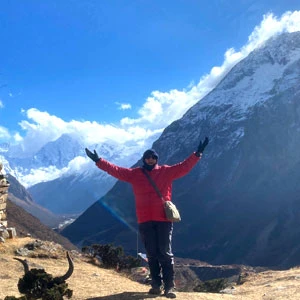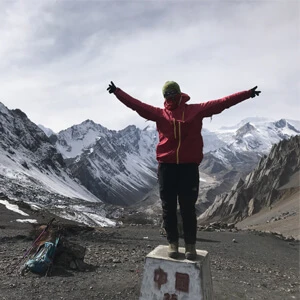What Permits Do I Need To Trek The Annapurna Region In Nepal?
Trekking in the Annapurna Region requires a bit of paperwork. The government of Nepal mandates permits to manage trekker safety, support local communities, and help preserve the fragile Himalayan ecosystem.
To legally enter and trek within the Annapurna Conservation Area, you will need two permits:
TIMS Card (Trekkers’ Information Management System): This card helps track trekkers for safety and rescue operations. It will cost you NRs 2,000 per person. As per the latest rule, you must obtain your TIMS card through an authorized trekking agency.
ACAP (Annapurna Conservation Area Permit): It is required for entry into the Annapurna Conservation Area to support conservation and development efforts. It will cost you NRs 3,000 per person and is valid for a single entry and covers all sections of the Annapurna Region, including Manang, Mustang, and Ghorepani.
You can obtain both the TIMS card and the ACAP permit from the Nepal Tourism Board Office in Bhrikutimandap or the Nepal Tourism Board Office in Pokhara. Here, Nepal Trekking Experts (NTE) will take care of the permits for you.
How Difficult is the Annapurna Throng Pass Trekking Route with Poon Hill Viewpoint?
The Annapurna Circuit with Thorong La Pass and Poon Hill viewpoint is a moderate to strenuous trek, stretching from lush forests at around 1,300 meters to the windswept heights of Thorong La Pass at 5,416 meters.
The trail itself is rugged, sometimes remote, often steep, and demands 6 to 8 hours of walking daily, with most days spent at high altitude. As the air thins, altitude sickness becomes a real concern, especially from Manang to Muktinath. But with our carefully crafted itinerary, you will acclimatize gradually.
This journey is perfect for adventurous trekkers with a decent fitness level, especially if you are craving a mix of alpine challenge and cultural immersion. And while beginners can also conquer this trek, Nepal Trekking Experts recommend that beginners come well-prepared and equipped.
With Nepal Trekking Experts, you are in the safest hands possible. Our guides are high-altitude trained, licensed, and experienced in handling AMS and tricky terrain, and they know when to push and when to pause. Similarly, our itinerary is designed with acclimatization, comfort, and scenery in mind; it includes stops in handpicked tea houses with warm meals and even warmer local hospitality.
The Best Season, Month, & Time For the Annapurna Round With Ghorepani Poon Hill Trek
The best trekking seasons for the Annapurna Round with Ghorepani Poon Hill are Spring (March to May) and Autumn (September to November), due to their stable weather and crystal-clear views. If you want the absolute best of both worlds, you must plan your trek in April or October, which are the peak months that blend vivid scenery with near-perfect trail conditions. And if you are wondering what time of day to hit the trail, early mornings win big with unbeatable visibility, pleasant temperatures, and active wildlife.
Spring Season (March to May)
Spring is when the Annapurna region shakes off its winter chill and bursts into life. The days get warmer, the skies clearer, and the hills bloom with a riot of wildflowers, especially the famous rhododendrons.
March: Early Spring
- Clear skies begin returning post-winter.
- Rhododendron buds start blooming across lower forests.
- Comfortable trekking temperatures (mild days, cold mornings).
- Fewer crowds on trails, which is ideal for peaceful trekking.
- Active birdlife including Himalayan monals and eagles.
- Holi festival celebrations in villages en route.
- Visibility improves daily with panoramic Himalayan views.
April: Peak Spring
- Best month for the Annapurna Circuit and Poon Hill views.
- Full rhododendron bloom creates vibrant forest trails.
- Crisp mountain panoramas of Dhaulagiri, Annapurna I, and Machhapuchhre.
- Stable weather, warm days, and cool nights.
- Trail-side villages buzz with trekkers and teahouse culture.
- Wildlife sightings increase with glimpses of langurs, pheasants, and Himalayan thar.
- Long daylight hours.
May: Late Spring
- Warm temperatures across all elevations.
- Wildflowers continue blooming higher up.
- Fewer trekkers than April.
- Hazy skies may appear late in the month due to monsoon hints.
- Excellent visibility at sunrise and early mornings.
- The local farming season begins.
- Autumn Season (September to November)
- Autumn is trekking royalty in Nepal. The post-monsoon freshness paints the landscapes bright and clean, and the skies become a canvas for crisp, uninterrupted views of the Himalayas.
September: Early Autumn
- Lush, green landscapes post-monsoon.
- Remaining monsoon humidity fades quickly.
- Trails are quieter early in the month.
- Waterfalls and rivers are full and powerful.
- Occasional clouds early in the month, but clearing fast.
- Clear skies by mid-September; start of sharp Himalayan views.
October: Peak Autumn
- Best month for the Annapurna Circuit with Poon Hill.
- Perfect weather with no rain, mild temperatures, and low wind.
- Crystal-clear views of Annapurna, Dhaulagiri, and beyond.
- Colorful forests, golden fields, and blue skies.
- Peak season, so expect more fellow trekkers.
- Dashain and Tihar festival celebrations along the way.
November: Late Autumn
- Cold mornings and evenings, but sunny and dry days.
- Golden landscapes with leaf-fall in forests.
- Fewer crowds compared to October.
- Best month for solitude and sharp visibility.
- Pre-winter atmosphere in the mountains.
- Dhaulagiri and Annapurna ranges look stunning in clear light.
Monsoon Season (June to August)
If you are trekking the Annapurna Circuit with Poon Hill during the Monsoon season, you must brace for adventure. June rolls in with moody afternoons and warm showers, but by July and August, it’s full-on downpour mode. The trails will get muddy, you will find leeches, and the visibility is minimal here.
Additionally, you will find hot and sticky air, with areas prone to landslides and flash floods. However, the lush greenery during this season is unreal. You will notice glowing rice paddies, mossy forests, wild orchids, and blooming magnolias. The jungle literally comes alive.
Furthermore, you may catch a glimpse or two of Himalayan monals and langurs swinging through soaked canopies. Altogether, the trail conditions are slippery and unpredictable, and with cloud-covered mountains. It’s not the best time to trek here unless you are an experienced hiker who actually enjoys mud, mist, and Monsoon madness. Still, if you are into raw, offbeat nature, you must be well-prepared with waterproof gear, clothing, and a flexible itinerary with buffer days.
Winter Season (December to February)
Trekking the Annapurna Circuit with Poon Hill in Winter isn’t for the faint-hearted, but it is totally doable and absolutely worth it if you come prepared. The higher you go, the colder it gets; you may find frozen water, biting winds, and snow-draped trails, especially around Thorong La Pass and the upper regions. However, the visibility is surprisingly stunning with crisp, clean skies framing the Annapurna and Dhaulagiri ranges. Here, you will also find fewer clouds and even fewer crowds.
The trail itself is quieter, less muddy, and more rugged. Tea houses still remain open along the main route, offering cozy shelter and warm meals, though facilities might be more limited in the higher villages. Wildlife isn’t as active, but you might catch Himalayan Thars or even snow monkeys darting through the pines. If you are trekking in Winter, you must be prepared for an adventure.
Annapurna Circuit With Poon Hill Trek In December 2025
Yes, December marks the beginning of Winter in Nepal, and sure, the crowds are long gone. But that’s the beauty of it. The trails are quiet, the views are crystal-clear, and you will get the raw, untouched side of the Annapurna region, without jostling through high-season foot traffic.
During this month, you will still catch the remnants of Autumn, especially in the lower elevations around Ghorepani and Poon Hill, with golden forests, crisp air, and clear skies. It’s cool, for sure, but totally bearable with the right layers. Additionally, in the lower areas, the days can be sunny and comfortable, however, near Manang and onwards, you may face pre-winter chills due to higher elevation.
With a trusted agency like NTE (Nepal Trekking Experts) guiding you, the Annapurna Circuit with Poon Hill Trek in December is safe and doable. You will be surrounded by frost-dusted peaks, serene alpine valleys, and peaceful tea houses.
Therefore, if you want a close-up views of the snowy Himalayan landscapes, the Annapurna Circuit with Ghorepani Poon Hill Trek in December is a perfect choice. You can start planning your Annapurna Circuit Poon Hill Trek for December 2025 now. Get in touch with us to customize your Winter journey with expert local support.
Do I Need A Guide And A Porter For The Annapurna Circuit Poon Hill Trek In Nepal?
Yes, you absolutely need a guide and porter for the Annapurna Circuit with Poon Hill Trek in Nepal. This iconic high altitude trek can be quite unpredictable. With altitudes soaring above 5,000 meters, thinning air, and the real risk of altitude sickness or injury, having a professional guide is mandatory.
At Nepal Trekking Experts, our guides are trained in high-altitude trekking, wilderness first aid, and emergency response. They are your safety net, your cultural interpreter, and your connection to the land. They will help you navigate the ever-changing Himalayan terrain, secure the best rooms when lodges are limited, and communicate clearly with locals along the way.
Without them, you might miss several magics of the trek, such as hidden monasteries, quiet side trails, and stories that only locals know. Our guides grew up in these mountains, and with them, you will be able to experience it all.
Now, NTE recommends you to pair that with experienced porters, who carry up to 20 kg of your gear. With them by your side, you will be able to focus on the views of Annapurna and Dhaulagiri, the warmth of tea houses, and the rhythm of the trail without being dragged by a heavy load. Plus, hiring local guides and porters supports the communities that keep this trekking region alive.
Moving on, a licensed guide costs around USD 30 to 35 per day, while a porter can cost more or less USD 25 per day. The guide and porter fees cover their salary, food, accommodation, and insurance. This cost does not include their tips. Now, tipping here is recommended and deeply appreciated, as it’s a way of saying thanks for a job done with heart.
All in all, every guide and porter in Nepal Trekking Experts are handpicked, insured, and deeply familiar with this route, so you can hike with full peace of mind.
Annapurna Circuit With Poon Hill Sunrise Trekking Preparation Tips
- Train at least 4 to 5 weeks before the trek: The Annapurna Circuit with Poon Hill Sunrise Trek consists of days of altitude gain, steep climbs, and rocky trails. You should start your cardio, strength, and endurance training weeks in advance.
- Know the best time to visit: For clear skies and stable weather, March to May and September to November are your golden windows.
- Pack smart and light: Your trekking gear should match the season. You must pack in layers with a good down jacket, moisture-wicking clothes, sturdy boots, and a solid sleeping bag.
- Hire a professional guide and porter: A licensed local guide from trusted agencies like Nepal Trekking Experts will keep you safe, informed, and on the right path (literally). Porters will lighten your load, so you enjoy nature instead of hauling 20 kg on your back.
- Research the trail before committing: Understand your route, side trips, altitude gains, and rest stops. You must know what you are getting into, so you are mentally ready.
- Budget beyond just the trek cost: Carry at least USD 200 to 300 in Nepali rupees to cover your personal expenses along the trail. It might be useful for snacks, wifi, charging, hot showers, guide/porter tips, and any personal purchases.
- Book with an authorized local trekking agency: A professional, safety-focused organizer like Nepal Trekking Experts will provide you with real value, such as custom itineraries, 24/7 support, insured staff, local expertise, and peace of mind.
Transportation for the Classic Annapurna Circuit with Poon Hill Trek
Getting to the trailhead is the first chapter of your Annapurna Circuit with Poon Hill Trek adventure. At Nepal Trekking Experts, we include all transportation arrangements in your trekking package. Depending on your comfort, time, and budget, you can choose between public or private transport options from Kathmandu to Besisahar, and then to Jagat, the actual starting point of the trek.
Bus or Microvan
If you want a cost-effective option and don’t mind a bit of local chaos, a public bus or microvan is the way to go. The journey starts at Gongabu Bus Park in Kathmandu, where you will board a microvan or bus headed for Besisahar, a scenic ride that takes about 6 to 7 hours. This ride generally starts early in the morning at around 6 am and takes you through hills, rivers, and bustling roadside towns.
These buses and vans are often cramped, untidy, and frequently stop to pick up and drop off locals, which can extend your travel time. Additionally, legroom is minimal, and you might find yourself sharing space with sacks of rice, caged chickens, or curious Nepali aunties. But if you want an immersive experience, this local bus ride offers a raw and real look into rural Nepal and its way of life. Here, the local bus ride from Kathmandu to Besisahar will cost you around NRs 1,000 per person.
Later from Besisahar, you will switch to another bus ride for the rugged off-road stretch to Jagat, which can take about 3 to 4 hours depending on road conditions. This section is bumpy, narrow, and dramatic. The ride is a thrilling adventure, perfect for those who enjoy a bit of excitement and don’t mind a few bumps along the way. This drive from Besisahar to Jagat will cost you NRs 2,000 per person.
Moving on, after your exploration ends in Muktinath, you will take a bus ride down to Tatopani. This drive will take about 4 to 5 hours, depending on road conditions. Along this ride, you will find narrow mountain cliffs, sharp turns, and a lot of bouncing around. It also offers epic views of the Kali Gandaki Gorge and dusty villages clinging to hillsides. This journey will cost around NRs 1,500 per person.
Once your trek officially wraps up at Hile, you will begin the final stretch back to Pokhara. However, you won't find a public bus here as there isn’t one yet. Instead, you will hop into a shared jeep, the only transport available on this bumpy road through the hills.
Private Jeep
If you are not into chaotic crowds and want a smoother start to your trek, you can travel via private jeep. Yes, it costs more than a local bus ride, but what you get in return is comfort, flexibility, and peace of mind. Your driver picks you up straight from your hotel in Kathmandu, and you can leave at your own pace.
The drive to Besisahar is much more relaxed in a private jeep, and it continues straight to Jagat without needing to switch vehicles. You will get to enjoy clean seats, legroom, fewer stops, and a chance to pause for breaks or photos when you feel like it. It’s especially ideal for groups, families, or anyone wanting to save time and energy before hitting the trail. This jeep ride from Kathmandu to Jagat will cost you NRs 30,000 (USD 250).
Moving on, you can also switch to a jeep ride from Muktinath to Tatopani, which will cost you NRs 14,000 (USD 100). Lastly, since the route from Hile to Pokhara does not have local bus service, you will need to take a jeep ride, and it costs NRs 8,000 (USD 60). Altogether, when you book with Nepal Trekking Experts, we ensure you get not only a well-maintained vehicle but also a reliable driver familiar with the terrain.
How Can I Prevent Altitude Sickness While Trekking Thorong La with Ghorepani Poon Hill?
Altitude sickness is a real concern, and on the Thorong La Pass Trek with Ghorepani Poon Hill, you will be climbing all the way up to 5,416 meters / 17,769 feet. That’s high enough to mess with your body if you are not paying attention. The real risk kicks in after 2,500 meters, and symptoms often sneak in during the higher stretches, especially between Manang and Muktinath, when the oxygen levels drop and the air gets noticeably thinner.
So, what does altitude sickness look like? It often starts quietly with a dull headache, loss of appetite, nausea, fatigue, or even dizziness. Paying attention to early signs of altitude sickness is key to staying safe. With proper preparation and a steady pace, you can avoid serious problems like HAPE or HACE, conditions that can affect anyone, no matter how fit or experienced.
Along the trail, if you start to feel symptoms, you must stop ascending, take a rest, and hydrate yourself. And even if it doesn't work, you should start descending to a lower level with the help of your guide. Our guides at Nepal Trekking Experts are trained to spot early signs of altitude sickness, give you first aid, and make quick, informed decisions.
To avoid altitude sickness, it’s important to take steps to prevent it from the beginning. You should follow the golden rule: climb high, sleep low, and gain no more than 500 meters of sleeping elevation per day once you cross 3,000 meters. Our Annapurna Circuit with Poon Hill Trekking itinerary is designed with that in mind. You will have proper pacing, rest days, and gradual altitude gain to give your body time to adapt.
Below are some of the tips and tricks to prevent altitude sickness during the trek:
- Drink at least 3 to 4 liters of water daily.
- Say a firm no to alcohol and smoking.
- Fuel your body with warm meals.
- Avoid taking sleeping pills and listen to your body.
- Don’t rush just to “make good time.” This isn’t a race.
- Walk slowly, breathe deeply, and let your body lead the way.
- If you are a beginner trekker or want to prevent altitude sickness from the start, you can carry Diamox after consulting with your doctor.
Meals, Drinking Water, Accommodation, and Hot Showers on the Annapurna Circuit Ghorepani Excursion
Meals In The Annapurna Trekking Region
You might be surprised by how much variety tea houses offer when you are trekking deep into the Himalayas. The menus may not change much from village to village, but they do have multiple items. On the Annapurna Circuit with Poon Hill Sunrise Trek, you will be served three meals a day: breakfast, lunch, and dinner, which are all included in your trekking package with Nepal Trekking Experts.
Breakfasts offer a cozy mix, such as fresh chapati or Tibetan bread with curry, or something lighter like porridge, muesli, eggs, pancakes, or toast with jam. When lunch and dinner roll around, Dal Bhat becomes your best choice. It is nourishing and comes with unlimited refills. Other staples include fried noodles, veggie fried rice, Thukpa (Tibetan noodle soup), Momo (local dumplings), spring rolls, or even pasta, burgers, and pizza if you are craving something more Western.
This trekking route is vegetarian and vegan-friendly, and if you have any special dietary needs, you must let us know beforehand. Your guide will personally coordinate with the kitchen staff to make sure you are taken care of. As for the drinks, you will also find an impressive selection of black, mint, ginger, masala, green, and lemon teas at most stops. While alcoholic drinks like beer, rum, and local rakshi might tempt you, we recommend skipping them at higher altitudes as they mess with your hydration.
And here's the bonus: when you trek with Nepal Trekking Experts, we will provide three meals a day with a cup of coffee or tea, along with a welcome or farewell dinner in Kathmandu to complete the experience. We will also keep you energized on the trail with seasonal fruits and snacks, though you are always free to grab your own stash along the way.
Is There Safe Drinking Water On The Routes Of The Annapurna Region?
Yes, but only if you do it right. While you will find plenty of water sources along the Annapurna Circuit with the Poon Hill Trek, not all of them are safe to drink straight from the stream. Most tea houses sell bottled water or boiled water for a price, but that cost adds up fast, both for your wallet and the environment. If you are planning an eco-friendly trekking in Nepal, you must carry your own reusable water bottle.
Along with the bottle, you must also bring water purification tablets or a filter. That way, you can refill from natural sources like springs or taps and still stay safe from stomach bugs. It’s cheaper, lighter, and way better for the mountains you came to admire. Whether you are trekking to Thorong La or watching the sunrise at Ghorepani Poon Hill, staying hydrated with safe drinking water is key to preventing altitude sickness, fatigue, and unnecessary hassles.
Accommodation on the Annapurna Circuit with Poon Hill Trek
Tea houses are the soul of trekking in Nepal, and on the Annapurna Circuit with Poon Hill, you will find plenty, from cozy comforts to bare-bones basics. In lower-altitude villages like Ghorepani or Chame, you will get more than you would expect in the Himalayas with proper beds, electricity, Wi-Fi, hot showers, western-style toilets, and sometimes even en suite bathrooms. It's almost luxurious compared to the altitude you are climbing.
But the higher you go, toward Thorong La or Yak Kharka, the simpler things get. You will find shared squat toilets, minimal furniture, and limited power. There are no room heaters, but you will only find them in the common hall, so you must carry your own sleeping bag. If you don’t have one, don’t worry, Nepal Trekking Experts will provide you with a proper one rated for sub-zero nights.
Are Hot Showers Available on The Annapurna Trekking Trail?
Hot showers on the Annapurna Circuit with Poon Hill Trek are available but at a cost. Almost at every stop, you will usually get proper hot showers, either solar-powered or gas-heated, which is perfect after a long, dusty day on the trail.
However, for a single night along the trekking journey in Thorong Phedi or Thorong High Camp, you won't find the hot shower facility. All in all, the cost of these hot showers will be a few hundred rupees.
Now, though you will find hot showers along the way, you must bring a pack of wet wipes for quick refreshes and skip the daily scrub to stay warm and conserve energy.
Electricity, Mobile Connection, And Wi-Fi Availability During The Ghorepani Trek via Annapurna Circuit
Electricity
Yes, there is electricity on the Annapurna Circuit with the Poon Hill Trek. Most tea houses in the Annapurna region run on either regular electricity or solar power. In lower-altitude villages, you might get lucky and have a plug socket right in your room. But more often than not, you will need to pay a small fee (in local rupees) to charge your phone or camera in the main dining area. The higher you climb, the more limited and expensive charging becomes. Therefore, you must bring a power bank.
Mobile Network & Connection
Surprisingly, yes, most villages along the Annapurna Circuit and Poon Hill Trek do have mobile network coverage these days. But this connection can be patchy, unpredictable, and depends heavily on luck and altitude. One minute you may be video-calling from Manang, the next you may be staring at “No Service” signs until the next village.
During this trekking journey, you must carry Nepal Telecom (NTC). Between the two SIM cards, NTC and Ncell, Nepal Telecom offers more reliable reception throughout the Annapurna region, especially in higher, more remote villages. Here, you can purchase a SIM card in Kathmandu right after you land (bring an ID copy), and top it up with a data pack so you can check maps, message family, or scroll a little when the trail gets quiet.
Wifi & Internet Connection
WiFi is available on the Annapurna Circuit and Ghorepani Poon Hill Trek. Most tea houses offer internet access for a small fee, which is around NRs 300 to 600 or USD 3 to 5 per night.
The WiFi connection here depends heavily on altitude, weather, and the mood of the mountains. And while most lower elevation lodges have semi-decent connectivity, once you climb higher, especially beyond Manang or near Thorong La, it gets spottier.
Pro tip: Don’t rely on WiFi for work or heavy uploads. Instead, grab a local SIM card (preferably Nepal Telecom) with data in Kathmandu.
Do I Need Travel Insurance to Trek The Annapurna Circuit With Ghorepani Poon Hill?
Yes, it is an absolute necessity. Travel insurance is your backup plan in a place where even the air gets thinner the higher you go. Any reputable trekking company in Nepal will require you to have insurance to join the Annapurna Circuit and Poon Hill trek.
You will be trekking at altitudes over 5,000 meters, crossing the infamous Thorong La Pass, and staying in remote Himalayan villages where there are no roads, let alone hospitals. If something goes wrong, altitude sickness, injury, or even bad weather, you will need a helicopter evacuation, and those cost thousands of dollars.
Here, your insurance policy must explicitly include trekking up to at least 6,000 meters, emergency helicopter evacuation, and medical coverage in Nepal. It will be a bonus if it also covers trip cancellation or delays due to weather.
And before purchasing, you must always read the fine print. Some insurers claim they cover high-altitude trekking, but sneakily exclude Nepal or anything above 4,000 meters. Don’t assume, but double-check and get written confirmation if needed.
Recommended Trekking Gear For The Annapurna Circuit With Poon Hill Trek
Clothing:
Moisture-wicking base layers (top & bottom)
Trekking shirts (quick-dry)
Insulated down jacket (lightweight but warm)
Fleece or softshell jacket
Waterproof & windproof outer shell (jacket & pants)
Trekking pants (lightweight and warm)
Warm hat/beanie
Sun hat or cap
Neck gaiter or buff
Gloves
Several pairs of wool or synthetic trekking socks
Underwear (quick-dry recommended)
Sports bra
Footwear:
Well-broken-in hiking boots (waterproof, high-ankle support)
Camp shoes or sandals (for tea house evenings)
Flip-flops or Crocs
Hiking socks
Trekking Gear:
Backpack (30 to 40L for your daily carry)
Duffel bag
Sleeping bag (rated to at least -10°C)
Trekking poles (adjustable, shock-absorbing recommended)
Headlamp with extra batteries
Reusable water bottle or hydration bladder (2L minimum)
Water purification tablets or a filter
Sunglasses with UV protection
Quick-dry towel
Dry bags or ziplocks (to protect electronics and clothes)
Power bank & charging cables
Adapter (Nepal uses Type C, D, and M plugs)
Personal Items:
Toiletries (toothbrush, toothpaste, biodegradable soap, etc.)
Sunscreen (SPF 30+)
Lip balm with SPF
Hand sanitizer
Wet wipes & face wipes
Toilet paper
Small first aid kit (blister plasters, paracetamol, ibuprofen, etc.)
Personal meds (if any)
Earplugs (for snoring dorm mates!)
Snacks (energy bars, nuts, chocolate)
Nepal Entry Visa Before Undertaking the Annapurna Circuit with Poon Hill Trek
If you are planning to trek the Annapurna Circuit with Poon Hill, first, you must get that Nepal entry visa sorted. Here, you can grab a visa on arrival at Tribhuvan International Airport in Kathmandu or just head to the visa kiosk, fill out the form, and pay your fee.
You can also apply for a visa at a Nepalese embassy or consulate in your home country if you prefer to arrive with one less thing on your list. Either way, you must make sure your passport is valid for at least six months from your arrival date.
Nepal offers 15, 30, or 90-day tourist visas, depending on how long you are planning to soak in those Himalayan views. For most trekkers on the Annapurna Circuit and Ghorepani Poon Hill route, the 30-day visa hits the sweet spot. You can pay in cash or by card at the visa fee counter, but heads up, cash is much faster and more reliable, especially when the network decides to ghost the payment machines.
Also, you must keep a printed copy of your hotel booking and return flight, just in case. Immigration usually waves you through, but when they ask, you will be glad you came prepared.
Why The Annapurna Circuit With Poon Hill Trek With The Nepal Trekking Experts?
If you are trekking the Annapurna Circuit with Poon Hill, who you go with matters just as much as the views, and Nepal Trekking Experts is the kind of team that turns a good trek into the adventure of a lifetime. We are the locals, mountain lovers, and your biggest hype squad out on the trail to keep you safe, inspired, and smiling from start to finish.
Here’s why you must trek the Annapurna Circuit with Poon Hill with Nepal Trekking Experts:
- Local roots and real impact: Our guides and porters are born and raised in the region, so your trek directly supports mountain communities.
- Decades of experience: We have walked these trails hundreds of times, through all kinds of weather, seasons, and surprises.
- Certified and trusted: We are fully licensed by TAAN, NMA, and the Nepal Tourism Board.
- Safety first, always: Every team member of NTE is trained in high-altitude trekking, first aid, and emergency response, so your safety is our topmost priority.
- 5-star reputation: We are loved and reviewed by hundreds on TripAdvisor.
- Flexible itineraries: Our itinerary is completely customizable as per your pace and budget. We also help you create a solo trek to Annapurna or a group journey.
- Free gear perks: If you do not have certain trekking gear, we will provide it for you, such as a down jacket, duffel bag, sleeping bag, and so on.
- Great value, no compromises: You get top-tier service without the tourist price tag. You will have quick and clear communication.
-
Whether you are chasing sunrise views from Poon Hill or conquering Thorong La Pass, you will go with a team that knows every stone, every shortcut, and every story behind the trail.
How Can I Book The Poon Hill Trek Via Annapurna Circuit?
Booking your Annapurna Circuit with Poon Hill Trek with Nepal Trekking Experts is simple, secure, and scroll-friendly, so you can lock in your Himalayan adventure without a single headache.
Here’s what you will need to get started:
- A valid passport (make sure it’s good for at least six more months).
- Your international flight info (if you have already booked it, no worries if not).
- An upfront deposit, 10% to reserve your trek and any domestic flights.
If you are booking with Nepal Trekking Experts, you can do it all online in a few clicks. You can pay securely on our website, and we will shoot you a confirmation receipt straight to your inbox.
Travel Note For Annapurna Circuit with Poon Hill Trekking
- Maximize your time in Nepal: If your schedule allows, extend your stay in Nepal. More days mean more time to explore beyond the trail and truly soak in Nepal’s rich culture and scenery. You can relax and enjoy in Pokhara valley or explore UNESCO World Heritage Sites in Kathmandu. You can also swing by Chitwan National Park, which is a top spot for wildlife and also a UNESCO site.
- Plan for the unexpected: Trekking seasons bring their own surprises, such as weather delays or trail conditions that might slow you down. Thus, Nepal Trekking Experts strongly recommend that you add a few extra buffer days to your itinerary for stress-free, worry-free trekking.
- Add flexible days for side trips: If you want to enjoy the detours, you should build in extra days to enjoy these side trips without rushing.
- Carry enough cash: Bring enough Nepali rupees in small denominations to cover personal expenses and emergencies.
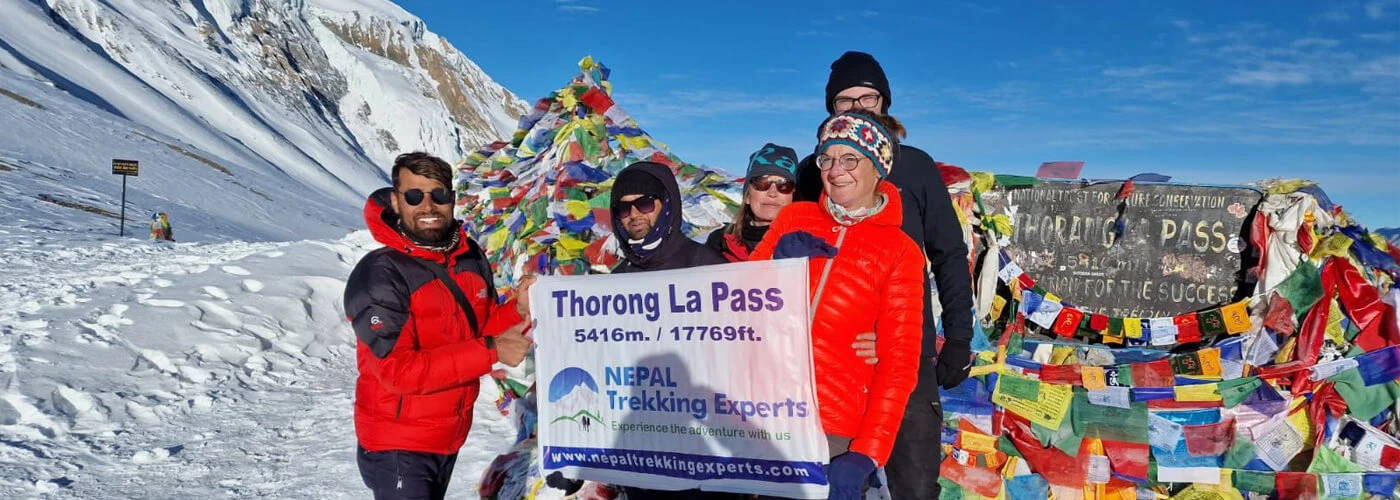
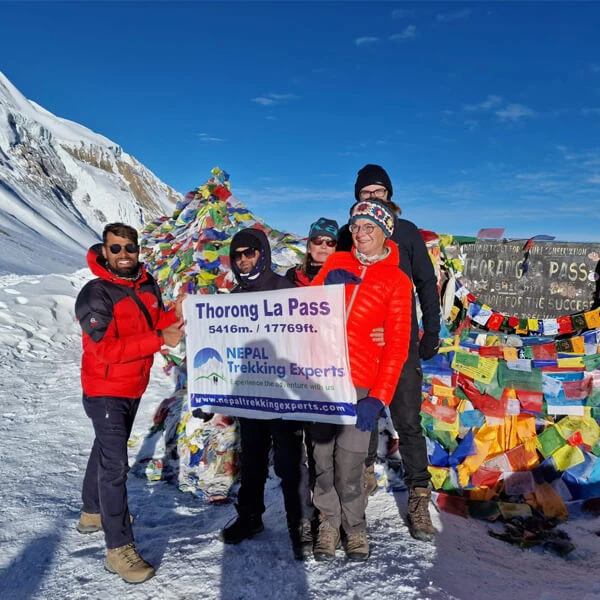
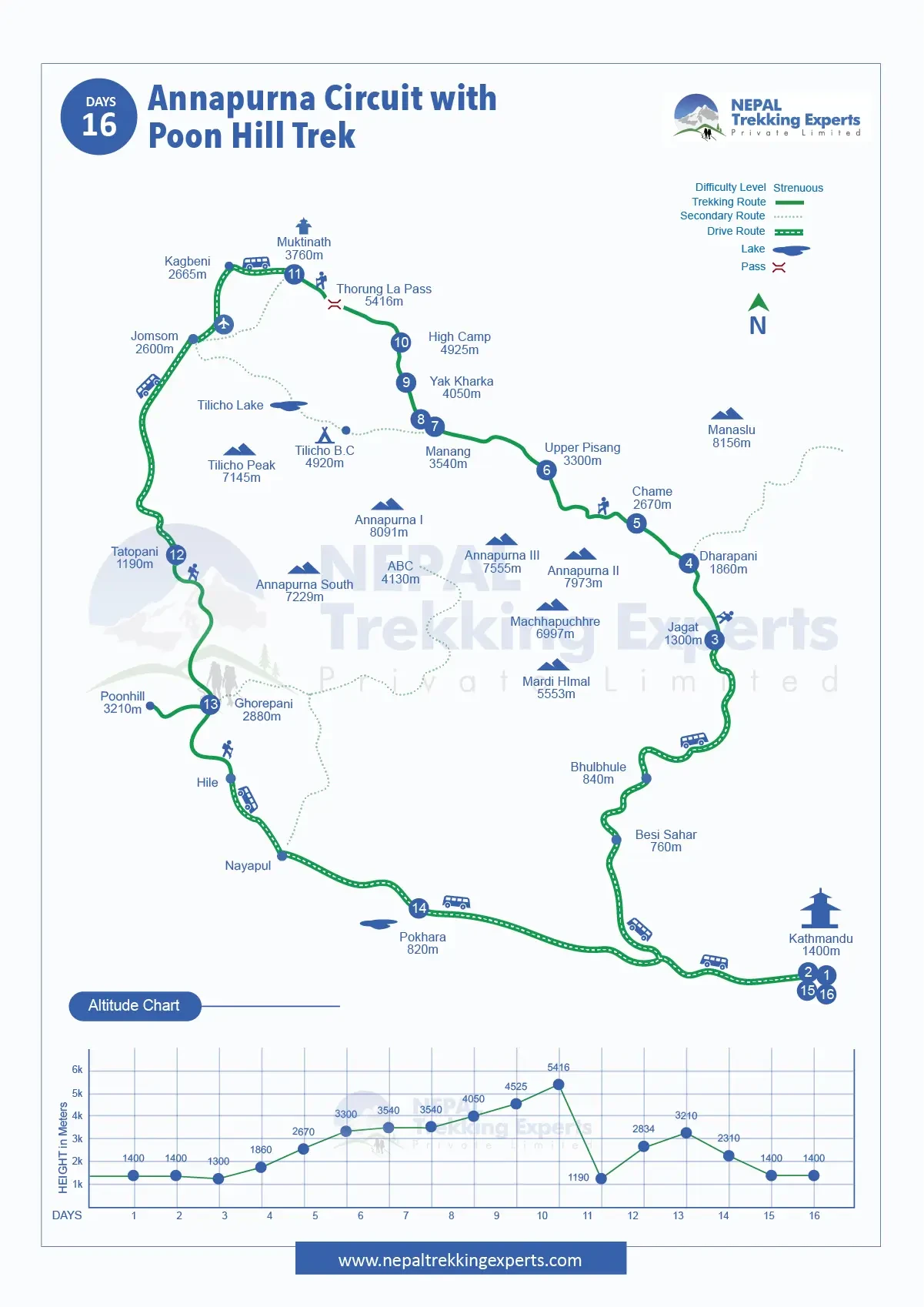
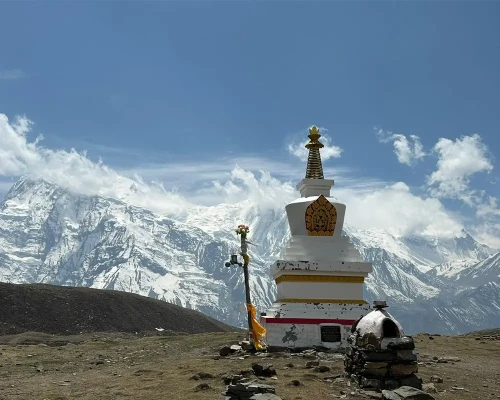
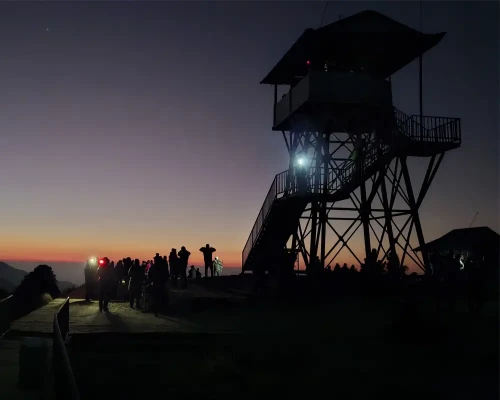
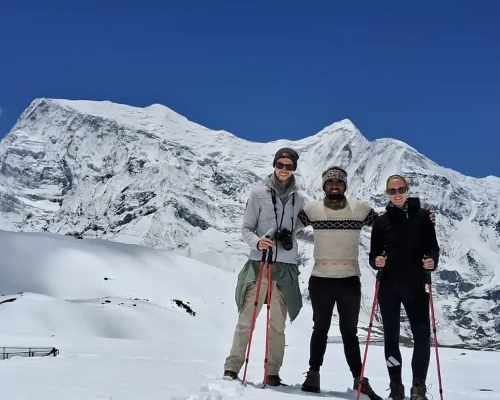
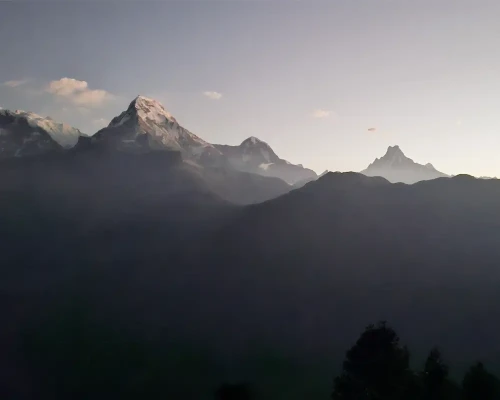
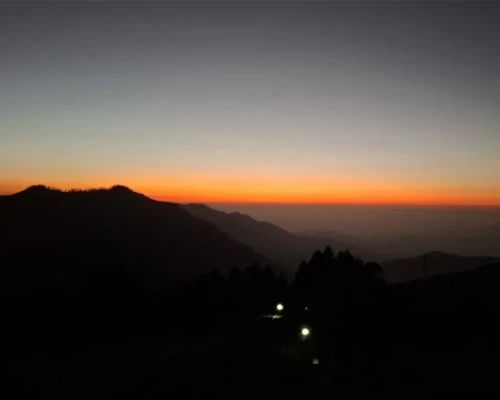
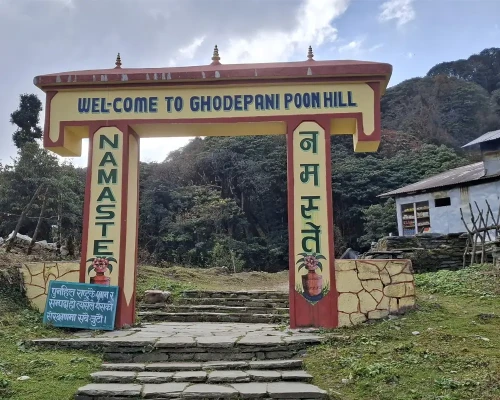

 based on 18 reviews
based on 18 reviews




